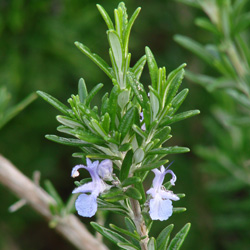(Bohemian Rosemary Sage) The origin of this clone is shrouded with age. It has been in my family since at least the 1930s. One of the largest and most durable varieties of this species, it is ideal for hedges and large spaces. After having this plant in my gardens for more than 60 years, I have finally named in in honor of my late grandfather, Frank Krozek.
The genus Rosmarinus is now included in Salvia, and we are very happy to carry this wonderful plant - whatever you call it.
In Bohemia, where Mr. Krozek was born in the 1890s, rosemary is widely used in cooking. Whether or not the seed for this clone came over to this country with him during his infancy, no one can say. We believe the family grew it in Pennsylvania where they settled. We'll likely never know with certainty where this plant originated.
The leaves are narrow, and the growth habit is quite upright, Flowers are deep blue and so numerous at times that the plant looks blue. Honeybees seem to especially like this one, preferentating it over other varieties in close proximity. We have a hedge here in Elk, California that has not received supplemental watering in 23 years.
The flavor is "classic", just what you would call "textbook rosemary". We use the long straight stems to skewer meats and vegetables to barbecue. And how can you make a tomato-based pasta sauce without rosemary?
New for 2018.

